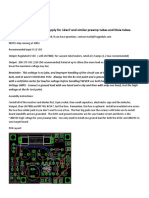0 ratings0% found this document useful (0 votes)
93 viewsRazor Ice Boat
Razor Ice Boat
Uploaded by
moma52ice boat
Copyright:
© All Rights Reserved
Available Formats
Download as PDF or read online from Scribd
Razor Ice Boat
Razor Ice Boat
Uploaded by
moma520 ratings0% found this document useful (0 votes)
93 views1 pageice boat
Original Title
razor-ice-boat
Copyright
© © All Rights Reserved
Available Formats
PDF or read online from Scribd
Share this document
Did you find this document useful?
Is this content inappropriate?
ice boat
Copyright:
© All Rights Reserved
Available Formats
Download as PDF or read online from Scribd
Download as pdf
0 ratings0% found this document useful (0 votes)
93 views1 pageRazor Ice Boat
Razor Ice Boat
Uploaded by
moma52ice boat
Copyright:
© All Rights Reserved
Available Formats
Download as PDF or read online from Scribd
Download as pdf
You are on page 1of 1
Plans for Making a ‘Racing
“RAZOR
are the materials used in building this simple,
fast and sure sailing iceboat. Balanced so
that she will sail herself in all winds not strong f
enough to tip her, it will be found that this style f
boat is the answer to those boys who have
often tried to make a workable miniature ice-
hoat, only to find that the balance was
wrong, that the thing was too heavy,
or that it would not steer.
You will not have such trouble
with this design. The writer built
her and knows what she'll do. %
And this is the exact design I used. é
This is how Razola is built:
take a piece of 3% in. box lumber
of soft clear straight grain. Make
one piece 5% in. wide and 3 in.
thick for the backbone. Taper this
for about 6 ins, from the front end
£9 as to form a jib boom. This
he ice sailor’s term for the reat
which anchors the front sail,
jib.
BLADE JCEBOAT
By T. S. ASGAARD
Re blades, box wood, and an old flour sack
Whoopee!
made from five pieces of wood, three corks, three
razor blades, a hairpin and some old cloth sacking.
It can sail itself and go as fast as 18 miles an hour!
Here’s a miniature iceboat
a ue
bgt
segle of inches,
Rozor blade
(SET pound ovk
Eorgct, blade
tumed down How corks are
fixed to runners.
“with sclesore
‘fee Vy
ar 0
fasteni
of mas ak
‘Rozor blade
How tiller is made.
Follow *the Abts Dimensions Closely to » lake ‘Sire of Best Results
M4
Another piece of the same thickness, but
1% ins. wide is used for the runner beam.
This runner beam is tapered from the
backbone to each end as shown in the
drawings so that the corks which form the
anchorages for therazor
blade runners can be
tacked on later. The
drawings make this all
clear. Then the run-
ner beam is fastened
to. the backbone with
shingle nails such as
can be found around
any new house build-
ing, and these are bent
over so as to firmly
clinch the two pieces.
Tn the back end of
the backbone a small
hole is drilled for the Mr. Asgs
heavy hairpin which a
holds the rudder blade. A knife slit will
do for this, but as the hairpin is apt to jog-
gle out in rough ice it is best to have a hole.
‘The hairpin is put through the hole with no
attempt to straighten out the humps. The
humps furnish a sort of resistance brake for
the rudder, holding it in whatever position
it is placed. The cork for the rudder is slit
for the razor blade, the hairpin is bent to be
put in as shown in the drawing. Then the
“sheet” is fixed. The back end of an iceboat
is always termed the sheet end.
The runner beam ends are hollowed for
receiving the corks. If they are not made to
fit the round shape of the cork it will be
hard to keep the corks nailed to the beam
ends. The tendency will be for them to
wiggle loose in any rough ice, and when
once loose they will come off quickly. They
are slit for the razor blades, which are put
in at an angle as indicated on the drawings.
In the boat I made and shown in the pic-
tures here, I took the razor blades and held
them slantwise across a scissors and round-
ed the fine cutting edge off. This makes a
better ice boat, because the fine sharp blade
usually is so sharp that unless the weather
is very cold the blade will settle into the ice
and freeze there. A blade with a scissors-
rounded edge will be much faster and easier
for the sails to move. It will do very little
sidewise drifting.
The mast and the sail must be put on.
MODERN MECHANICS AND
Mr. Asgaard’s razor blade fceboat
has furnished him much fun,
143
INVENTIONS
The mast is a piece of box wood whittled to
around. Do a good job here, friends, be-
cause the shape of the mast just in front of
the sail has a lot to do with the speed of an
iceboat. See the drawings. If the mast is
crookedly whittled the
flow of wind onto the
sail is interrupted and
the sail will not be
nearly so efficient, This
has been learned from
experiments conducted
in Germany by those
iceboat fans who have
looked to airplane de-
velopment so as to see
what they could do by
bettering the design of
their « iceboats. They
found that a smooth
spar in front of the
sail makes all the dif-
ference between a winning speed and a
speed which is just moving. The same holds
true of the gaff and the boom. Whittle them.
to a nice round,
When these are cut to length, the sail is
stitched on over hand with a sort of canoe
stitch. The drawings explain. The sail is
made of soft cotton cloth such as comes
from flour sacks. The edge is laid with
curvature in it so that when the wind bellies
it it will be straight along the spar. About
a Yj inch curvature is right for each edge.
Keep the up and down the mast side straight.
Tt does not need a curve because the sail
doesn’t bend along the mast.
The gaff and the boom are bent onto the
mast as shown. A tack is driven into the
mast, stout linen thread is placed about it in
lieu of a set of jaw fittings. The whole thing
works well in the boat I built.
‘The guy wires are merely linen thread of
the extra stout kind wrapped around the
masthead, the end of the jib boom, and the
runner beam ends. The mast is fastened
with a long nail as shown in the drawing
and will be easy to take down so that the
whole sail can be wrapped up when the
craft is being taken to the lake for a trial
spin.
In sailing the boat, remember that an ice-
boat can go much faster than the yind which
is pushing it. It slides across the ice at an
angle to the wind,
You might also like
- The Subtle Art of Not Giving a F*ck: A Counterintuitive Approach to Living a Good LifeFrom EverandThe Subtle Art of Not Giving a F*ck: A Counterintuitive Approach to Living a Good LifeRating: 4 out of 5 stars4/5 (6024)
- The Gifts of Imperfection: Let Go of Who You Think You're Supposed to Be and Embrace Who You AreFrom EverandThe Gifts of Imperfection: Let Go of Who You Think You're Supposed to Be and Embrace Who You AreRating: 4 out of 5 stars4/5 (1132)
- Never Split the Difference: Negotiating As If Your Life Depended On ItFrom EverandNever Split the Difference: Negotiating As If Your Life Depended On ItRating: 4.5 out of 5 stars4.5/5 (911)
- Grit: The Power of Passion and PerseveranceFrom EverandGrit: The Power of Passion and PerseveranceRating: 4 out of 5 stars4/5 (628)
- Hidden Figures: The American Dream and the Untold Story of the Black Women Mathematicians Who Helped Win the Space RaceFrom EverandHidden Figures: The American Dream and the Untold Story of the Black Women Mathematicians Who Helped Win the Space RaceRating: 4 out of 5 stars4/5 (937)
- Shoe Dog: A Memoir by the Creator of NikeFrom EverandShoe Dog: A Memoir by the Creator of NikeRating: 4.5 out of 5 stars4.5/5 (548)
- The Hard Thing About Hard Things: Building a Business When There Are No Easy AnswersFrom EverandThe Hard Thing About Hard Things: Building a Business When There Are No Easy AnswersRating: 4.5 out of 5 stars4.5/5 (358)
- Her Body and Other Parties: StoriesFrom EverandHer Body and Other Parties: StoriesRating: 4 out of 5 stars4/5 (831)
- Elon Musk: Tesla, SpaceX, and the Quest for a Fantastic FutureFrom EverandElon Musk: Tesla, SpaceX, and the Quest for a Fantastic FutureRating: 4.5 out of 5 stars4.5/5 (481)
- The Emperor of All Maladies: A Biography of CancerFrom EverandThe Emperor of All Maladies: A Biography of CancerRating: 4.5 out of 5 stars4.5/5 (275)
- The Little Book of Hygge: Danish Secrets to Happy LivingFrom EverandThe Little Book of Hygge: Danish Secrets to Happy LivingRating: 3.5 out of 5 stars3.5/5 (434)
- The Yellow House: A Memoir (2019 National Book Award Winner)From EverandThe Yellow House: A Memoir (2019 National Book Award Winner)Rating: 4 out of 5 stars4/5 (99)
- The World Is Flat 3.0: A Brief History of the Twenty-first CenturyFrom EverandThe World Is Flat 3.0: A Brief History of the Twenty-first CenturyRating: 3.5 out of 5 stars3.5/5 (2281)
- Devil in the Grove: Thurgood Marshall, the Groveland Boys, and the Dawn of a New AmericaFrom EverandDevil in the Grove: Thurgood Marshall, the Groveland Boys, and the Dawn of a New AmericaRating: 4.5 out of 5 stars4.5/5 (273)
- The Sympathizer: A Novel (Pulitzer Prize for Fiction)From EverandThe Sympathizer: A Novel (Pulitzer Prize for Fiction)Rating: 4.5 out of 5 stars4.5/5 (125)
- A Heartbreaking Work Of Staggering Genius: A Memoir Based on a True StoryFrom EverandA Heartbreaking Work Of Staggering Genius: A Memoir Based on a True StoryRating: 3.5 out of 5 stars3.5/5 (233)
- Team of Rivals: The Political Genius of Abraham LincolnFrom EverandTeam of Rivals: The Political Genius of Abraham LincolnRating: 4.5 out of 5 stars4.5/5 (235)
- On Fire: The (Burning) Case for a Green New DealFrom EverandOn Fire: The (Burning) Case for a Green New DealRating: 4 out of 5 stars4/5 (75)
- Hitachi SR 2004 Service ManualDocument38 pagesHitachi SR 2004 Service Manualmoma52No ratings yet
- The Unwinding: An Inner History of the New AmericaFrom EverandThe Unwinding: An Inner History of the New AmericaRating: 4 out of 5 stars4/5 (45)
- 1808 BK8 ManualDocument8 pages1808 BK8 Manualmoma52No ratings yet
- Klon Centaur ENGDocument3 pagesKlon Centaur ENGmoma52No ratings yet
- Mkiii SveDocument1 pageMkiii Svemoma52No ratings yet
- Phase LockDocument35 pagesPhase Lockmoma52No ratings yet
- Cheapskate Iceboat Small 4 12 14Document33 pagesCheapskate Iceboat Small 4 12 14moma52No ratings yet
- SMPS Charge Pump Power Supply Documentation 1.1Document5 pagesSMPS Charge Pump Power Supply Documentation 1.1moma52No ratings yet
- Cmobile Uk AER60Document6 pagesCmobile Uk AER60moma52No ratings yet
- Hitachi Ht-324 TurntableDocument16 pagesHitachi Ht-324 Turntablemoma52No ratings yet
- HikCentral Professional Quick Start Guide 2.0.1 20210128Document48 pagesHikCentral Professional Quick Start Guide 2.0.1 20210128moma52No ratings yet
- Win7 Manual EngDocument138 pagesWin7 Manual Engmoma52No ratings yet
- Hitachi SR 4410 Service ManualDocument3 pagesHitachi SR 4410 Service Manualmoma52No ratings yet
- Hitachi D 22 S Service ManualDocument12 pagesHitachi D 22 S Service Manualmoma52No ratings yet
- MC14521B 24-Stage Frequency Divider: Marking DiagramsDocument9 pagesMC14521B 24-Stage Frequency Divider: Marking Diagramsmoma52No ratings yet
- Vacuum Tubes Available in The Loadline Calculator - Vacuum Tube Amplifiers - DIY PDFDocument1 pageVacuum Tubes Available in The Loadline Calculator - Vacuum Tube Amplifiers - DIY PDFmoma52No ratings yet
- Transfer Switches: Manual, Motorized, Automatic and Bypass SwitchesDocument106 pagesTransfer Switches: Manual, Motorized, Automatic and Bypass Switchesmoma52No ratings yet
- Installation and Operating Instructions: Automatic Control Units, OMD200 and 300Document48 pagesInstallation and Operating Instructions: Automatic Control Units, OMD200 and 300moma52No ratings yet
- Section A-A End View of Assembly Top View of Assembly: 27134PSLADocument1 pageSection A-A End View of Assembly Top View of Assembly: 27134PSLAmoma52No ratings yet


























































